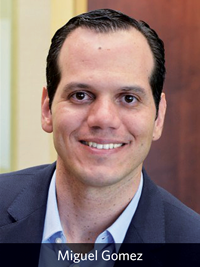 Miguel Gomez serves as Wealth Advisor (Hispanic Investors) at Lauterbach Financial Advisors in El Paso, Texas
Miguel Gomez serves as Wealth Advisor (Hispanic Investors) at Lauterbach Financial Advisors in El Paso, Texas
We all know how the average financial advisor looks. This has been described in many studies. And we all know that the wealth gap is a real issue. The question now is, where do we go from here?
One example is the “fee for service” model, such as the one promoted by XY Planning Network. It is not a coincidence that XYPN has a more diverse pool of advisors relative to the industry as a whole and, as a result, communities that have been typically underserved (or flat-out ignored by the industry) are now getting fiduciary, unbiased financial advice.
Another model that could get more traction is the one used by firms such as Financial Finesse that deliver financial wellness as an employee benefit paid by the employer. In this case the advisor’s job is not to sell, as her salary is paid by the employer that hired the financial wellness firm. Who is served through this service? All the employees of a company, from janitorial to the C-Suite. There’s no distinction based on wealth or income.
These two approaches could help serve more diverse populations and would certainly make a tremendous difference for many consumers.
If changing your business model does not sound practical to you, then at least consider offering an hour per month of pro-bono financial planning services. Imagine the lives that you can change. I see it every week from the comments I receive from people who listen to my podcast.
And then there’s the larger question: How do we diversify the financial industry itself by diversifying the talent pool?
It begins with the desire to do so. Look for talent where you typically don’t. And, once you find it, recognize that you will probably need to do things you weren’t expecting to do. It happened at my firm when I first joined them more than 10 years ago.
I came from a very different background than all the other advisors and executives at the firm. My English was rough. I had a desire to do many things, and the firm was open to those discussions and to executing on those that made sense. They offered me help in the areas where I needed it. They didn’t try to fit me into a mold. Instead, they mentored me and gave me the opportunity to shine with my own talents and abilities.
And, of course, they have challenged me to be better and to grow. I wish for all of my fellow Latino, Black and other advisors from underrepresented groups to experience what I have experienced. I don’t think it’s been easy for my colleagues, but I think we’ve all grown as a firm as a result.








